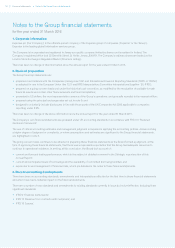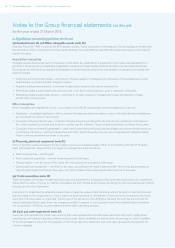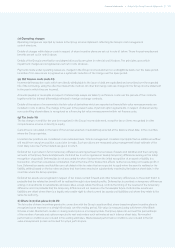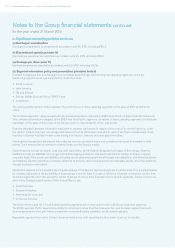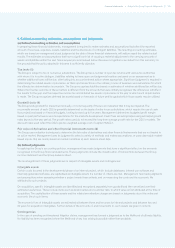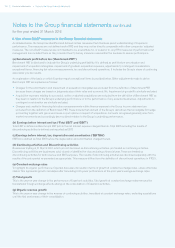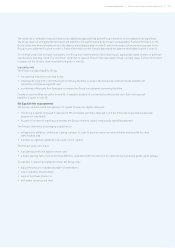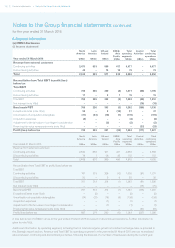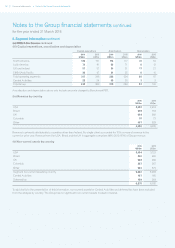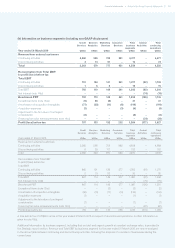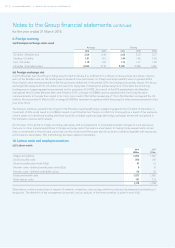Experian 2016 Annual Report Download - page 127
Download and view the complete annual report
Please find page 127 of the 2016 Experian annual report below. You can navigate through the pages in the report by either clicking on the pages listed below, or by using the keyword search tool below to find specific information within the annual report.
125•Notes to the Group nancial statementsFinancial statements
5. Critical accounting estimates, assumptions and judgments
(a) Critical accounting estimates and assumptions
In preparing these financial statements, management is required to make estimates and assumptions that affect the reported
amount of revenues, expenses, assets, liabilities and the disclosure of contingent liabilities. The resulting accounting estimates,
which are based on management’s best judgment at the date of these financial statements, will seldom equal the related actual
results. The estimates and assumptions that have a significant risk of causing a material adjustment to the carrying amounts of
assets and liabilities within the next nancial year are summarised below. Revenue recognition is excluded from this summary on
the grounds that the policy adopted in this area is sufficiently objective.
Tax (note 15)
The Group is subject to tax in numerous jurisdictions. The Group has a number of open tax returns with various tax authorities
with whom it is in active dialogue. Liabilities relating to these open and judgmental matters are based on an assessment as to
whether additional taxes will be due, after taking into account external advice where appropriate. Signicant judgment is required in
determining the related assets or provisions, as there are transactions in the ordinary course of business and calculations for which
the ultimate tax determination is uncertain. The Group recognises liabilities based on estimates of whether additional tax will be due.
Where the nal tax outcome of these matters is different from the amounts that were initially recognised, the differences will affect
the results for the year and the respective income tax and deferred tax assets or provisions in the year in which such determination
is made. The Group recognises deferred tax assets based on forecasts of future profits against which those assets may be utilised.
Goodwill (note 19)
The Group tests goodwill for impairment annually, or more frequently if there is an indication that it may be impaired. The
recoverable amount of each CGU is generally determined on the basis of value-in-use calculations, which require the use of cash
flow projections based on nancial budgets, looking forward up to five years. Management determines budgeted profit margin
based on past performance and its expectations for the market’s development. Cash ows are extrapolated using estimated growth
rates beyond a five-year period. The growth rates used do not exceed the long-term average growth rate for the CGU’s markets. The
discount rates used reflect the CGU’s pre-tax weighted average cost of capital (‘WACC’).
Fair value of derivatives and other financial instruments (note 28)
The Group uses valuation techniques to determine the fair value of derivatives and other nancial instruments that are not traded in
an active market. Management uses its judgment to select a variety of methods and makes assumptions, or uses observable market-
based inputs, that are mainly based on market conditions at each balance sheet date.
(b) Critical judgments
In applying the Group’s accounting policies, management has made judgments that have a significant effect on the amounts
recognised in the Group financial statements. These judgments include the classification of transactions between the Group
income statement and the Group balance sheet.
The most significant of these judgments are in respect of intangible assets and contingencies:
Intangible assets
Certain costs incurred in the developmental phase of an internal project, which include databases, internal use software and
internally generated software, are capitalised as intangible assets if a number of criteria are met. Management has made judgments
and assumptions when assessing whether a project meets these criteria, and on measuring the costs and the economic life
attributed to such projects.
On acquisition, specific intangible assets are identified and recognised separately from goodwill and then amortised over their
estimated useful lives. These include items such as brand names and customer lists, to which value is first attributed at the time of
acquisition. The capitalisation of these assets and the related amortisation charges are based on judgments about the value and
economic life of such items.
The economic lives of intangible assets are estimated at between three and ten years for internal projects and between two and
20 years for acquisition intangibles. Further details of the amounts of, and movements in, such assets are given in note 20.
Contingencies
In the case of pending and threatened litigation claims, management has formed a judgment as to the likelihood of ultimate liability.
No liability has been recognised where the likelihood of any loss arising is possible rather than probable.





